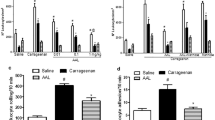Abstract
PAF-acether is a potent aggregating agent released by various cells involved in acute inflammatory process. In this paper, exogenous PAF-acether has been investigated for its ability to generate signs of inflammation (edema measured by plethysmometry) and hyperalgesia (Randall-Sellito test) by standard subplantar injection in the rat paw. From 0.005 μg, PAF-acether induced significant edema of the paw, maximal 1 hour after injection; it was dose-dependent from 0.1 to 5 μg. Significant dose-dependent hyperalgesia occurred from 1.25 μg; it reached a plateau from 2 to 4 hours after injection. Both phenomena were long-lasting (>6 h). PAF-acether was 1.5 to 10 times stronger than PGI2 and PGE2 in inducing edema, pain, and in increasing vascular permeability. We investigated the interaction of miscellaneous drugs with the edema and the hyperalgesia caused by 2.5 μg of PAF-acether. Non-steroidal anti-inflammatory (NSAI) drugs exerted only moderate effects on the edema without affecting hyperalgesia. Edema was highly reduced by various agents: prednisolone,l-cysteine, anti-calcic drugs, theophylline, PGI2, salbutamol, clonidine. All of them, except clonidine, and in contrast to NSAI drugs, were more potent on PAF-acether edema than on kaolin edema; a possible link between these agents is their ability to increase cyclic AMP levels in the cells and consequently to reduce lysosomal enzyme release. PAF-acether itself, injected intra-peritoneally, inhibited PAF-acether edema without preventing pain, at doses inactive on arterial pressure and hematocrit, but inducing marked gastric mucosal damage. Among the drugs tested, including analgesics, only PGI2 and imidazole improved PAF-induced hyperalgesia, showing a dissociation between edema and hyperalgesia not only in their induction (doses of PAF required, time course of the phenomena), but in the drugs able to antagonize their development too.
Similar content being viewed by others
References
P.M. Henson,Activation of rabbit platelets by platelet-activating factor derived from IgE-sensitized basophils. Characteristics of the aggregation and its dissociation from secretion, J. Clin. Invest.60, 481–490 (1977).
J. Benveniste, P.M. Henson andC.G. Cochrane,Leucocyte-dependent histamine release from rabbit platelets: The role of IgE-basophils and platelet-activating factor, J. Exp. Med.136, 1356–1376 (1972).
J.M. Lynch, G.Z. Lotner, S.J. Betz andP.M. Henson,The release of a platelet-activating factor by stimulated rabbit neutrophils, J. Immunol.123, 1219–1226 (1979).
J.M. Mencia-Huerta andJ. Benveniste,Platelet-activating factor and macrophages. I—Evidence for the release from rat and mouse peritoneal macrophages and not from mastocytes, Eur. J. Immunol.9, 409–415 (1979).
R.N. Pinckard, R.S. Farr andD.J. Hanahan,Physicochemical and functional identity of rabbit platelet-activating factor (PAF) released in vivo during IgE anaphylaxis with PAF released in vitro from IgE-sensitied basophils, J. Immunol.123, 1847–1857 (1979).
L.O. Randall andJ.J. Sellito,A method for measurement of analgesic activity on inflamed tissue, Arch. Int. Pharmacodyn.111, 409–419 (1957).
G. Kaley andR. Weiner,Prostaglandin E 1:A potential mediator of the inflammatory response, Ann. N.Y. Acad. Sci.180, 338–351 (1971).
S. Masumoto andC. Masuda,The mechanism of anti-inflammatory action of 2-(2-fluoro-4-biphenylyl) propionic acid (flurbiprofen), Folia Pharmac. Japon.72, 753–762 (1976).
R.R. Gorman, S. Bunting andO.V. Miller,Modulation of human platelet adenylate cyclase by prostacyclin (PGX), Prostaglandins13, 377–388 (1977).
J.P. Bilezikian, A.M. Dornfeld andD.E. Gammon,Structure-binding-activity analysis of beta-adrenergic amines — I. Binding to the beta-receptor and activation of adenylate cyclase, Biochem. Pharmac.27, 1445–1454 (1978).
L.J. Ignarro, Cyclic nucleotides and lysosomal enzyme secretion. InCyclic 3′,5′-Nucleotides: Mechanisms of Action, pp. 189–206 (EdsH. Cramer andJ. Schultz), John Wiley and Sons, London 1977.
N. Sakamoto, M. Terai, T. Takenaka andH. Maeno,Inhibition of cyclic AMP phosphodiesterase by 2,6-dimethyl-4-(3 nitrophenyl)-1,4-dihydropyridine-3,5-dicarboxylic acid 3-[2(N-benzyl-N-methylamino)]-ethyl ester 5-methyl ester hydrochloride (YC-93), a potent vasodilator, Biochem. Pharmac.27, 1269–1274 (1978).
R.W. Butcher andC.E. Baird,Effects of prostaglandins on adenosine 3′5′-monophosphate levels in fat and other tissues, J. Biol. Chem.243, 1713–1717 (1968).
S. Moncada, S. Bunting, K. Mullane, P. Thorogood andJ.R. Vane,Imidazole: A selective inhibitor of thromboxane synthetase, Prostaglandins13, 611–618 (1977).
Author information
Authors and Affiliations
Rights and permissions
About this article
Cite this article
Bonnet, J., Loiseau, A.M., Orvoen, M. et al. Platelet-activating factor acether (PAF-acether) involvement in acute inflammatory and pain processes. Agents and Actions 11, 559–562 (1981). https://doi.org/10.1007/BF01978740
Issue Date:
DOI: https://doi.org/10.1007/BF01978740




